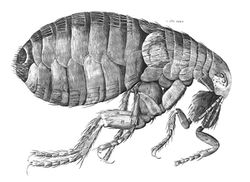Difference between revisions of "Flea Structure"
Jump to navigation
Jump to search
(Created page with 'thumb|right|250px|Robert Hooke's famous flea from Micrographia The terms '''ctenidia''' and '''combs''' can be used interchangably for spines on the head/thor…') |
|||
| Line 1: | Line 1: | ||
[[Image: flea.jpg|thumb|right|250px|Robert Hooke's famous flea from Micrographia]] | [[Image: flea.jpg|thumb|right|250px|Robert Hooke's famous flea from Micrographia]] | ||
| + | [[Image:Flea Diagram.jpg|thumb|right|150px|Flea Diagram - Wikimedia Commons]] | ||
The terms '''ctenidia''' and '''combs''' can be used interchangably for spines on the head/thorax. Spines on the cheeks are referred to as '''genal''' and spines on the thorax are called '''pronotal''' combs. The presence and location of the chitinous spines are important in differentiating between the different flea species. The chitinous anal struts are also used for identification and help the flea larvae with vigorous motility. | The terms '''ctenidia''' and '''combs''' can be used interchangably for spines on the head/thorax. Spines on the cheeks are referred to as '''genal''' and spines on the thorax are called '''pronotal''' combs. The presence and location of the chitinous spines are important in differentiating between the different flea species. The chitinous anal struts are also used for identification and help the flea larvae with vigorous motility. | ||
[[Category:Fleas]] | [[Category:Fleas]] | ||
Revision as of 23:09, 19 May 2010
The terms ctenidia and combs can be used interchangably for spines on the head/thorax. Spines on the cheeks are referred to as genal and spines on the thorax are called pronotal combs. The presence and location of the chitinous spines are important in differentiating between the different flea species. The chitinous anal struts are also used for identification and help the flea larvae with vigorous motility.

